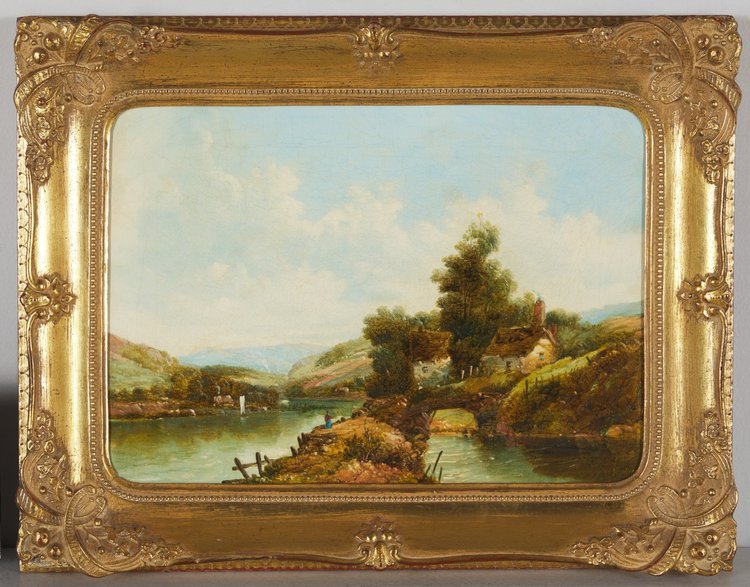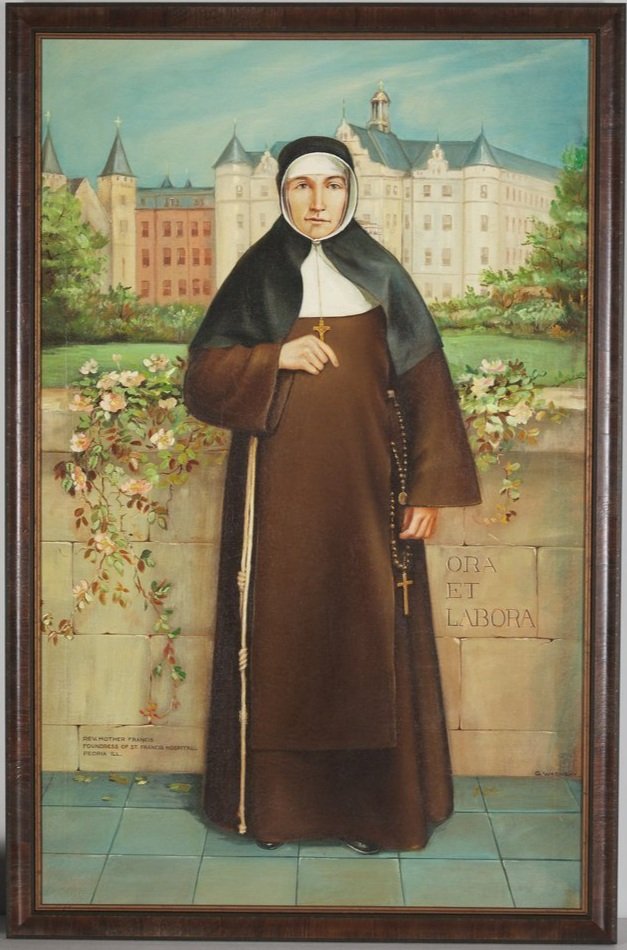"Father of the National Parks," John Muir famously said, "The mountains are calling, and I must go." Mountains call to so many. Adventurers hike mountains to commune with nature. Athletes climb mountains to test their skills and conquer the terrain. Artists paint mountains to capture the scope and majesty of their beauty. The mountain in this landscape painting looms large over a lake and valley, with a snowcapped summit. Unfortunately, the delicate details of this painting had languished with years of discoloration and damage.
An Important Carved Maple High Chest of Drawers
This high chest of drawers is attributed to Marjo John Dunlap of Bedford, New Hampshire, circa 1970. As published by Leigh Keno American Antiques, "this high chest represents the highly innovative craftsmanship of Major John Dunlap (1746-1792) and Lt. Samuel Dunlap (1752- 1830), pioneers of a multigenerational family of cabinetmakers who worked in south-central New Hampshire in the late eighteenth and nineteenth centuries."
Preserving Pulp Paintings: Wings and Adventure
An avid pulp art collector, Doug has brought his new acquisitions to The Center for years. We recently had the pleasure to conserve two pulp art paintings for Doug - Wings, November 1932, and Adventure, "He Told Them That he was the Incarnated Spirit of Prester John.” March 1911. They are always welcomed by Senior Paintings Conservator Amber Schabdach, who has shared she "absolutely loves working on them as they are fun to look at, and always look amazing once cleaned" These paintings are the original art for the pulp book covers; pulp covers were designed to draw in the reader and are an iconic and collectible part of the science fiction genre.
Preparing Three Partridges
French painter Pierre-Auguste Renoir (1841 - 1919) was a leader in the Impressionist painting style. Renoir is known for his use of light and shadow, capturing the atmosphere of the subject matter he was painting. Three Partridges is a still-life oil on canvas painted by Renoir circa 1880 and is part of the Arkansas Museum of Fine Art (AMFA) collection in Little Rock, Arkansas. While AMFA is undergoing an expansion and renovation by Studio Gang Architects (who also designed our facility), The Conservation Center is assisting with the care and conservation of items from their collection.
Poissons on a Panel Painting
Panel paintings are particularly temperamental. Before painting on canvas became popular, paintings were often executed on wood panels. This could be either a single board or panels joined together, often with a grid of wooden slats on the back to provide support called a cradle. This is the case with Etude de Poissons de Mer Panneau. A still-life study of sea fish, this cradled panel painting is attributed to Jan Brueghel the Younger. Brueghel was a Flemish painter, who lived from 1601-1678, placing this painting from the 17th century and approximately 400 years old. The current owner's father purchased the painting years ago, who loves this painting "because of the skill of painters at that time ... plus this painting is by the grandson of the great Pieter Bruegel the Elder!"
Particularities of Parchment
As a conservation laboratory with 40 years of history and ten conservation departments, we see a wide variety of items for treatment. All come with their nuances and peculiarities, and parchment is no exception. Parchment - writing sheets made from prepared animal skins - presents particular challenges for conservators and framers. While everything may seem ordinary, what often happens inside a parchment piece's frame tells another story.
Miniature Instruments and The Story of AMLI
"When I first heard that The Center had a collection of instruments coming into the lab for treatment, I was not envisioning that they would all fit on my desk mat." But fit they did - all thirteen miniature instruments in total that came under the care of Senior Conservator of Furniture Rob Kleeman. As Rob shared, the project was interesting due to its "scale," but the story behind the curios illustrates the immense size of their importance.
The Ethics of Appraisers and Conservators
When we say we treat items of all kinds at The Conservation Center, we truly mean it. Whether a noteworthy painting by a blue-chip artist or a purely sentimental artwork by a client's child, the team at The Conservation Center always provides quotes for treatment based on time and materials, never considering the item's market value. A conservator should never assign value and always refer clients to independent appraisers with appraisal questions. Some wonder why this is, and the answer is the conservator code of ethics.
The Center's 2023 New Year Staff Art Contest: Emergence
To kick off the new year, we held an art competition amongst our talented staff this January. Creations were submitted and after our vote, we are proud to share the winning entry from Associate Paintings Conservator Rebecca Vodehnal, the runner-up entry by Senior Conservation Framer Scott Dietrich. Cheers to 2023!
EXPO CHICAGO 2023
The Conservation Center is excited to return to THE INTERNATIONAL EXPOSITION OF CONTEMPORARY & MODERN ART for our 9th year. EXPO CHICAGO returns for a four-day event (April 7 - 10) taking place at historic Navy Pier, featuring more than 140 of the world’s leading art galleries from 16 countries. This fair draws visitors from all over and continues to demonstrate Chicago as an important destination in the art world. As we have for the past nine years, The Center is proud to serve as EXPO CHICAGO’s exclusive art conservation and custom framing provider. Our conservators will also be on-call and on-site to assist dealers and galleries whose pieces have sustained damage related to transportation and handling.
Picture Perfect Portrait Paintings
Portrait painting is a form of art practiced by artists for centuries. People have always wanted to preserve the essence of their loved ones tangibly, and portraiture is the art of representing a person or figure in paint. From the cave paintings of early man to masterpieces by the greatest artists throughout history, painted portraits were the only way to commemorate an individual until the advent of photography in the mid-1800s. Now, with access to digital photography at the tip of our fingers, the sheer number of photographs that exist today is a testament to how significant portraits are.
A Queen Anne Bureau with a Surprise
Though today we call it a desk, this striking piece of furniture is a stunning example of a Queen Anne period bureau. Queen Anne-style furniture was predominant from the 1720s to the 1760s. This bureau, likely constructed circa 1730, is a stunning example of the craftsmanship and design of the time.
Looking Back at 2022: The Video Highlights
Photography Finds and their Chicago Connections
Lorin remembers the day he found the photograph in the early 1990s. After lunch with his parents - "at the new version of the Belden Deli" - they made their way to a garage sale in the gymnasium at Francis Parker School in the Lincoln Park neighborhood of Chicago. Lorin recalls, "We walked into the gymnasium, and I saw this photo of a ballet dancer in a ratty wooden frame. It had a $5 tag on it."
A Painting from Home: Elvey Bridge by A.H. Vickers
Patrick Henry O'Brien was born in Laurium, Michigan, on March 15, 1868. His parents, Mary and Patrick, were immigrants from County Cork, Ireland, who settled in the Keweenaw Peninsula, Michigan, in 1863. The area was known as Copper County for the prevalent copper mining from the 1850s through the 1960s. Patrick lost both his father and uncle to mining accidents, leading him down a very different path.
"Serve with the Greatest Care and Love" Conserving a painting of Mother M. Frances Krasse
Mother M. Frances Krasse left behind a legacy when she passed away from tuberculosis at the age of 46 in 1885. An emigrant from Germany, Mother M. Frances only spent nine years in Illinois. Along with five other Sisters, she arrived in Peoria in 1876 to start a hospital they named called St. Francis Hospital and was appointed the local superior. The following year, they formed a new congregation - Sister of the Third Order of St. Francis of Peoria, with Mother M. Frances serving as the first Mother General.
A Community Comes Together: The Fisher Foundation Project Part 2
In 2014, a small group of volunteers in Marshalltown, Iowa, met to discuss the restoration of the Fisher Community Center Art collection, which had been untouched since the 1960s. The artworks were in desperate need for repair, care, and cataloguing, so the group set to work filing for grants and hiring specialists to help.
A Letter from Heather Becker, CEO of The Conservation Center
The Conservation Center CEO, Heather Becker, shares an update on the state of the company and staff since the start of the COVID pandemic in March 2020.
I sent out a letter in March 2020 at the beginning of the pandemic, and then I sent an update in September 2020, which ended with "so stay tuned."
As many of you know, we have been writing and sending out monthly newsletters for the last 15 years, and a great number of you are loyal readers. So, thank you for "staying tuned," whether over the last 2 or 15 years, as our community of 30,000+ readers has grown.
Treating a Delicate Textile
Samplers are a type of embroidery traditionally used to showcase a person's needlework skills. During the 17th and 18th centuries, samplers became increasingly popular. They were common among young girls as a way to learn needlework and teach different stitching techniques. Samplers were also used as a way to record family history, often given as gifts or hung on the wall as a decorative item.
Portrait Photograph with a Layered Frame
Even when they may seem simple, almost every treatment carried out in The Center's laboratory is a collaborative effort between different conservations and departments. This photograph, "Portrait of George Ramige" is a family antique and arrived in stable condition but with age-related issues. A reinforced photograph housed in an antique frame, this artwork was treated in three of our departments; Works of Art on Paper, Furniture, and Custom Framing and Display.





















